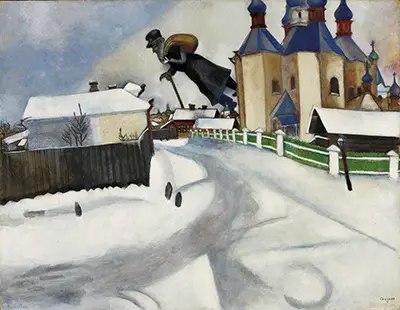In compositional terms, it seems one of Chagall’s less puzzling paintings – with fewer mysteries or symbolic allusions to decode. We recognise the traditional style of the townscape. Formally, it seems an easy picture to read.
Yet there is a paradox in this. Few of Chagall’s fully realised paintings provide as much of a key to understanding the origins and context of this most remarkable of 20th century painters.
Over Vitebsk is a painting of Chagall’s hometown, and in some ways it remains an identifiable landscape. Snow still blankets its winter streets, and onion domes – like those of the city’s famous Cathedral of the Blessed Virgin Mary – are as distinctive elements in the skyline as the sandstone-yellow building that Chagall has depicted.
However, in one respect at least, it is unrecognisable to the community into which Chagall was born. None of its 50 synagogues have survived since the turn of the 20th century, and the formerly significant shtetl population of predominantly Ashkenazi Jews has left few traces that could survive the violence and state hostility of the past 100 years. However, “Over Vitebsk” has much to say about the position of Chagall’s community in his own day.
It has been easy for observers to mis-label the painting’s central figure. The archetype of the ‘Wandering Jew’ – represented for at least a millennium in Western European words and images – has been imprinted with definitions and associations by a predominantly non-Jewish culture. This, surely, is not the place to start. The identification with the ‘schnorrer’ or beggar from within Yiddish culture is also mistaken: this is a character-type defined by relations within a community, and by those who can joke at an all-to-well-known personality and attitude, at someone who belongs.
Rather, it is hard not to see the dark, bearded figure, his face turned away, as a representation of the exodus from Tsarist Russia – a displaced and dispossessed émigré among the several hundred thousand who had left and would continue to leave Eastern Europe in the days of Chagall’s childhood. An image suggesting such a migration has relevance at a time when stories of displacement and ethnic identity have such media currency. However, as the painting reminds us, such questions never cease to be current for those who identify – or are identified – with them.
Over Vitebsk represents stylistic traits that were key to Chagall’s life. He was influenced by the Cubist style of Braque and Picasso from his time in Paris - though this way of seeing could hardly eclipse Chagall’s strongly unique vision of the world. The tracks of traffic in the snow, the triangular and segmented lines in the white and grey foreground, immediately call to mind the stronger Cubist style of his still-lifes. And even in one of the more conventional paintings, the floating figure projected against the snow-clouds is characteristic of what the poet Apollinaire called “surnaturel”.
An image under a “sad, damp-charged afternoon sky”, a series of ‘dreamscapes’ and a confession: “Had I not been lonely, none of my works would have happened”. A description not of Chagall, but of the British painter LS Lowry. An artist of profoundly different influences and career, Lowry nonetheless represents an interesting point of comparison. The black, cypher-like figures present one visual link, as does his choice of palette “I am a simple man: ivory, black, vermilion… flake white”.
A motif of floating or flying may suggest freedom. In Franz Kafka’s mysterious short story “The Knight of the Bucket”, it does not. In a wartime winter, a man walks through freezing streets, unsuccessfully looking to fill his coal bucket. Eventually, the empty bucket becomes so light that it lifts him and carries him away. As Italo Calvino has noted, emptiness and flying as “a symbol of privation and desire and seeking, raising you to a point where a humble request can no longer be satisfied... opens a road to endless reflection.”
